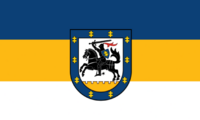Baltican Navy
| Baltican Naval Force Baltijos karinės jūrų pajėgos | |
|---|---|
 | |
| Active | c. 17th century AD - Initial Foundation |
| Country | |
| Branch | Navy |
| Role | Naval warfare, Patrolling |
| Size | 8,331 active duty personnel 20 ships |
| Part of | Baltican Armed Forces |
| Garrison/HQ | Port Svoyev |
| Patron | Saint Rein |
| Motto(s) | "Sons of the Sea, brothers of the free" |
| Colors | Golden Yellow, Prussian Blue |
| Commanders | |
| Head Admiral | Yvo Falk |
| Insignia | |
| Ensign |  |
| Naval Jack |  |
The Baltican Navy is the naval branch of the Baltican Armed Forces. The Baltican navy was once a vital component of Balticas ability to export its power across the Kezanoi and Keelpijp seas, and has historically been the primary reasons behind the Dolch's control over Baltica.It was formally established in 1642, becoming an official separate branch of the then Royal Army. After the first Baltican civil war, the Royal Navy was replaced by the Peoples Republic Navy. In the aftermath of the second Baltican Civil war the Peoples Republic Navy was reformed into the Baltican Navy.
History
Although the Baltican Navy was only officially formed in 1642, for over three centuries a crude navy operated in tandem with the Order of Baltishtin and then later the Kingdom of Baltica. Various rivercraft would often flow between large rivers like the Balandeli and Liplan, often getting into fights with lesser Baltican tribes and their meager fishing boats. However, the primary goal and objective of the not yet established navy were to maintain stability within the Kezanoi SeaIn order to protect the valuable trade routes to Dolchland . Because the Navy was so decentralized, it would often struggle to perform, and infighting was quite common. Piracy was rampant outside of established trade routes, and fishing boats would be subject so constant pillaging. This lack of order would eventually lead to the formation of the Royal Navy.
The 17th century saw trade in the Kezanoi Sea explode, as the Baltican economy saw huge growth and Baltican merchants began to establish themselves in other states. However, as trade increased the amount of piracy in the Sea exploded exponentially, to the point where it was beginning to impact the economy of the Kingdom of Baltica. To combat this piracy, King Wilmar II would formally sign a decree which oversaw the creation of a Baltican Royal Navy. Using lumber from the recently integrated region of Kretia, King Wilmar financed the creation of two fleets, which he then sent to the St Bunno Island (Which had been under Pirate control for two decades). His new fleet would be victorious, and once again the Kezanoi Sea trade routes would be stable. This would also lead to the full integration of the Eastern Islands along the Baltican coast, which became private domains of the Baltican Royal Family.
Past 1710, piracy in the Kezanoi Sea fell dramatically , to the point where ships could sail across the Sea without fear of attack. This largely contributed to the expansion of the Pearl Cities, who flourished during this age of economic expansion.
After the first Baltican Civil war, what remained of the Royal Navy was re-organised into the Peoples Republic Navy. President and dictator Algridas Benis would end up dedicating a significant amount of money towards the Navy, not because of any actual need, but simply because he could. Under his reign, the Baltican navy grew to be one of the largest in Southern Argis, dispite the nation being on the brink of economic ruin. Additionally, the development of Submarines and Battleships was criticized for being quite wasteful as they would rarely see use due to both oil and funding shortages. This waste would see the Baltican Navy grow in size, but its functionality stagnate, whilst technological development would also similarly slow as most financing would end up going to the construction of more vessels, rather than keeping up with the times.
During the Second Baltican Civil War most of the navy fell into the hands of Admiral Stefan Huber, who took the navy and beached most of it on St Casimir Island, where he became the de facto head of state. Former Admiral Gerd Stube would end up seizing a Corvette and using it to lead a raid against the city of Diems and other Dokestven ports. By July of 2022, most of the various navy factions would seize operations as they would run out of heavy fuel, as did most of Baltica during the war. After the Amber Resolution, all former Navy Vessels owned by the Island of St Casimir would end up transferring their ships back to the Central Baltican Government.
Bases
Currently the Baltican Navy only has one Naval Base, this being Port Svoyev in the Belgorta SREP. Current plans are to further expand the Navies facilities, and an ongoing deal is being negotiated with Liplan-Kretin to possibly purchase the port facilities in Goja and Kretia, in hopes of further expanding the Baltican fleet in the future, and possibly create a second Northern Fleet or a separate Coast Guard.
Fleet
The current main Baltican fleet is comprised of 20 ships, all of whom are located in the Amber Lake. In total there is 10 Patrol ships, 5 corvettes, 3 Mine layer / support vessels and 1 frigate.
| Name | Picture | Origin | Class | Type | Built | Entered service (LNF) | Notes |
|---|---|---|---|---|---|---|---|
| Corvette Squadron | |||||||
| N42 Federales | 
|
Flower-class corvette | Corvette Naval Ship | 1977 | 1980 | Current Capital Ship of the Baltican Navy. | |